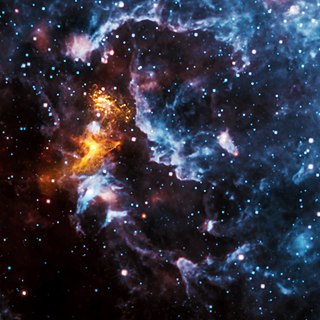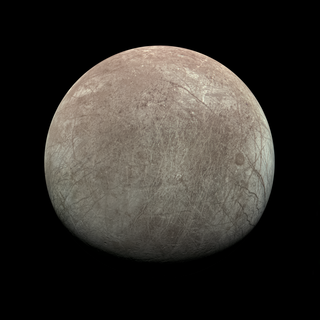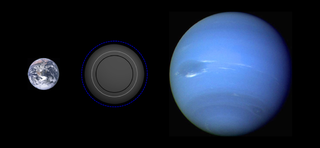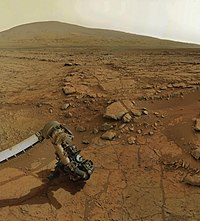
An exoplanet or extrasolar planet is a planet outside the Solar System. The first possible evidence of an exoplanet was noted in 1917 but was not then recognized as such. The first confirmation of the detection occurred in 1992. A different planet, first detected in 1988, was confirmed in 2003. According to statistics from the NASA Exoplanet Archive, As of 17 October 2024, there are 5,780 confirmed exoplanets in 4,314 planetary systems, with 969 systems having more than one planet. The James Webb Space Telescope (JWST) is expected to discover more exoplanets, and to give more insight into their traits, such as their composition, environmental conditions, and potential for life.

A neutron star is the collapsed core of a massive supergiant star. It results from the supernova explosion of a massive star—combined with gravitational collapse—that compresses the core past white dwarf star density to that of atomic nuclei. Except for black holes, neutron stars are the smallest and densest known class of stellar objects. They have a radius on the order of 10 kilometers (6 mi) and a mass of about 1.4 M☉. Stars that collapse into neutron stars have a total mass of between 10 and 25 solar masses (M☉), or possibly more for those that are especially rich in elements heavier than hydrogen and helium.

A planetary system is a set of gravitationally bound non-stellar bodies in or out of orbit around a star or star system. Generally speaking, systems with one or more planets constitute a planetary system, although such systems may also consist of bodies such as dwarf planets, asteroids, natural satellites, meteoroids, comets, planetesimals and circumstellar disks. For example, the Sun together with the planetary system revolving around it, including Earth, form the Solar System. The term exoplanetary system is sometimes used in reference to other planetary systems.

PSR B1620-26 b is an exoplanet located approximately 12,400 light-years from Earth in the constellation of Scorpius. It bears the unofficial nicknames "Methuselah" and "the Genesis planet" due to its extreme age. The planet is in a circumbinary orbit around the two stars of PSR B1620-26 and is the first circumbinary planet ever confirmed. It is also the first planet found in a globular cluster. The planet is one of the oldest known extrasolar planets, believed to be about 12.7 billion years old.
PSR B1257+12, previously designated PSR 1257+12, alternatively designated PSR J1300+1240, is a millisecond pulsar, 2,300 light-years from the Sun, in the constellation Virgo, rotating at about 161 times per second. It is also named Lich, after a powerful, fictional undead creature.

A pulsar is a highly magnetized rotating neutron star that emits beams of electromagnetic radiation out of its magnetic poles. This radiation can be observed only when a beam of emission is pointing toward Earth, and is responsible for the pulsed appearance of emission. Neutron stars are very dense and have short, regular rotational periods. This produces a very precise interval between pulses that ranges from milliseconds to seconds for an individual pulsar. Pulsars are one of the candidates for the source of ultra-high-energy cosmic rays.

A millisecond pulsar (MSP) is a pulsar with a rotational period less than about 10 milliseconds. Millisecond pulsars have been detected in radio, X-ray, and gamma ray portions of the electromagnetic spectrum. The leading hypothesis for the origin of millisecond pulsars is that they are old, rapidly rotating neutron stars that have been spun up or "recycled" through accretion of matter from a companion star in a close binary system. For this reason, millisecond pulsars are sometimes called recycled pulsars.

Planetary habitability is the measure of a planet's or a natural satellite's potential to develop and maintain environments hospitable to life. Life may be generated directly on a planet or satellite endogenously or be transferred to it from another body, through a hypothetical process known as panspermia. Environments do not need to contain life to be considered habitable nor are accepted habitable zones (HZ) the only areas in which life might arise.

A binary pulsar is a pulsar with a binary companion, often a white dwarf or neutron star. Binary pulsars are one of the few objects which allow physicists to test general relativity because of the strong gravitational fields in their vicinities. Although the binary companion to the pulsar is usually difficult or impossible to observe directly, its presence can be deduced from the timing of the pulses from the pulsar itself, which can be measured with extraordinary accuracy by radio telescopes.

Gliese 581c is an exoplanet orbiting within the Gliese 581 system. It is the second planet discovered in the system and the third in order from the star. With a mass about 6.8 times that of the Earth, it is classified as a super-Earth.

The habitability of natural satellites is the potential of moons to provide habitats for life, though it is not an indicator that they harbor it. Natural satellites are expected to outnumber planets by a large margin and the study of their habitability is therefore important to astrobiology and the search for extraterrestrial life. There are, nevertheless, significant environmental variables specific to moons.

PSR B1257+12 c, alternatively designated PSR B1257+12 B, also named Poltergeist, is an extrasolar planet approximately 2,300 light-years away in the constellation of Virgo. It was one of the first planets ever discovered outside the Solar System, and is one of three pulsar planets known to be orbiting the pulsar Lich.

PSR B1257+12 C, alternatively designated PSR B1257+12 d and also named Phobetor, is a super-Earth exoplanet orbiting the pulsar Lich approximately 2,315 light-years away from Earth in the constellation of Virgo. It was one of the first planets ever discovered outside the Solar System. It was discovered using the pulsar timing method, where the regular pulses of a pulsar are measured to determine if there is a planet causing variations in the data.

PSR B1937+21 is a pulsar located in the constellation Vulpecula a few degrees in the sky away from the first discovered pulsar, PSR B1919+21. The name PSR B1937+21 is derived from the word "pulsar" and the declination and right ascension at which it is located, with the "B" indicating that the coordinates are for the 1950.0 epoch. PSR B1937+21 was discovered in 1982 by Don Backer, Shri Kulkarni, Carl Heiles, Michael Davis, and Miller Goss.

Astrophysical X-ray sources are astronomical objects with physical properties which result in the emission of X-rays.

An exoplanet is a planet located outside the Solar System. The first evidence of an exoplanet was noted as early as 1917, but was not recognized as such until 2016; no planet discovery has yet come from that evidence. What turned out to be the first detection of an exoplanet was published among a list of possible candidates in 1988, though not confirmed until 2003. The first confirmed detection came in 1992, with the discovery of terrestrial-mass planets orbiting the pulsar PSR B1257+12. The first confirmation of an exoplanet orbiting a main-sequence star was made in 1995, when a giant planet was found in a four-day orbit around the nearby star 51 Pegasi. Some exoplanets have been imaged directly by telescopes, but the vast majority have been detected through indirect methods, such as the transit method and the radial-velocity method. As of 24 July 2024, there are 7,026 confirmed exoplanets in 4,949 planetary systems, with 1007 systems having more than one planet. This is a list of the most notable discoveries.

K-type main-sequence stars, also known as orange dwarfs, may be candidates for supporting extraterrestrial life. These stars are known as "Goldilocks stars" as they emit enough radiation in the non-UV ray spectrum to provide a temperature that allows liquid water to exist on the surface of a planet; they also remain stable in the main sequence longer than the Sun by burning their hydrogen slower, allowing more time for life to form on a planet around a K-type main-sequence star. The planet's habitable zone, ranging from 0.1–0.4 to 0.3–1.3 astronomical units (AU), depending on the size of the star, is often far enough from the star so as not to be tidally locked to the star, and to have a sufficiently low solar flare activity not to be lethal to life. In comparison, red dwarf stars have too much solar activity and quickly tidally lock the planets in their habitable zones, making them less suitable for life. The odds of complex life arising may be better on planets around K-type main-sequence stars than around Sun-like stars, given the suitable temperature and extra time available for it to evolve. Some planets around K-type main-sequence stars are potential candidates for extraterrestrial life.

The theorized habitability of red dwarf systems is determined by a large number of factors. Modern evidence suggests that planets in red dwarf systems are unlikely to be habitable, due to their low stellar flux, high probability of tidal locking, likely lack of magnetospheres and atmospheres, and the high stellar variation such planets would experience. However, the sheer number and longevity of red dwarfs could provide ample opportunity to realize any small possibility of habitability.

Pulsar planets are planets that are orbiting pulsars. The first such planets to be discovered were around a millisecond pulsar in 1992 and were the first extrasolar planets to be confirmed as discovered. Pulsars are extremely precise clocks and even small planets can create detectable variations in pulsar traits; the smallest known exoplanet is a pulsar planet.

A Habitable Zone for Complex Life (HZCL) is a range of distances from a star suitable for complex aerobic life. Different types of limitations preventing complex life give rise to different zones. Conventional habitable zones are based on compatibility with water. Most zones start at a distance from the host star and then end at a distance farther from the star. A planet would need to orbit inside the boundaries of this zone. With multiple zonal constraints, the zones would need to overlap for the planet to support complex life. The requirements for bacterial life produce much larger zones than those for complex life, which requires a very narrow zone.





















